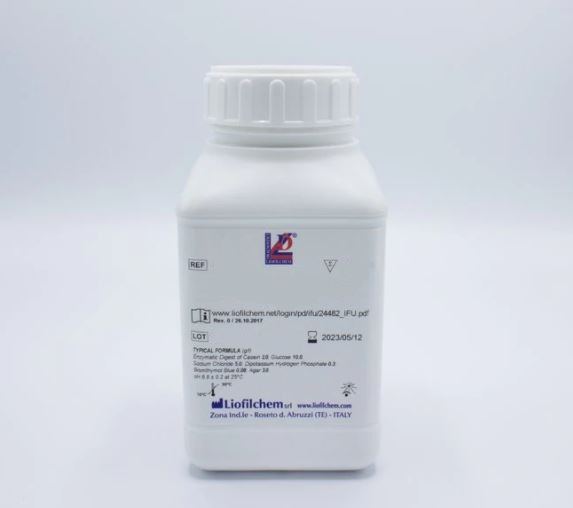Specifications:
| Application | Microbiology | ||
| Storage Temperature | Room Temperature | ||
| Product Type | Culture Medium | Forms | Powder |
| Product Brand | Liofilchem | ||
| Product Grade | Microbiology grade | ||
Bile Aesculin Azide Agar is a selective medium specifically formulated for the detection, enumeration, and confirmation of enterococci in water and other environmental samples. The medium is designed to comply with ISO 7899-2 standards, ensuring accuracy and reliability in laboratory testing for water quality and microbiological monitoring.
Key Features
- Selective for Enterococci
- Incorporates ox-bile and sodium azide to inhibit non-enterococcal Gram-positive and Gram-negative bacteria, ensuring selective growth of enterococci.
- Confirmatory Medium
- Used to confirm red-pink colonies grown on primary isolation media (e.g., Slanetz Bartley Agar) for enterococci by the bile-aesculin reaction.
- Aesculin Hydrolysis Indicator
- Enterococci hydrolyze aesculin to produce aesculetin, which reacts with ferric ammonium citrate to form a black-brown complex.
- Compliance with ISO Standards
- Meets the requirements of ISO 7899-2 for water quality testing via the membrane filtration method.
- Versatile Applications
- Suitable for detecting enterococci in water samples, environmental testing, and other material analyses.
- Convenient Packaging
- Available in 100 g, 500 g, and 5 kg formats for laboratory flexibility.
Composition (per liter)
| Ingredient | Concentration (g/L) |
|---|---|
| Tryptone | 17.0 |
| Peptone | 3.0 |
| Yeast Extract | 5.0 |
| Ox-Bile | 10.0 |
| Sodium Chloride | 5.0 |
| Aesculin | 1.0 |
| Ferric Ammonium Citrate | 0.5 |
| Sodium Azide | 0.15 |
| Agar | 15.0 |
| Final pH | 7.1 ± 0.1 @ 25°C |
Preparation Instructions
- Suspend 56.7 g of the powder in 1 liter of distilled or deionized water.
- Heat to boiling while mixing thoroughly to dissolve the medium completely.
- Autoclave at 121°C for 15 minutes.
- Cool to 45–50°C and pour into sterile Petri dishes.
- Store the prepared plates at 2–8°C and protect from light.
Technique
ISO 7899-2 (Membrane Filtration Method):
- Filter the water sample through a 0.45 µm membrane filter.
- Transfer the membrane onto Slanetz Bartley Agar and incubate aerobically at 36 ± 2°C for 40–48 hours.
- Transfer colonies (red-maroon-pink) from Slanetz Bartley Agar onto Bile Aesculin Azide Agar (preheated to 44°C).
- Incubate at 44 ± 0.5°C for 2 hours.
- Interpret Results: Enterococci produce colonies with a tan-black coloration in the surrounding medium due to aesculin hydrolysis.
Alternative Inoculation Methods:
- Spread Plating, Pour Plating, or Direct Streaking.
- Incubate plates at 35 ± 2°C for 18–24 hours.
Interpretation of Results
| Microorganism | Growth | Observation |
|---|---|---|
| Enterococcus faecalis ATCC 19433 | Good | Blackening of medium |
| Enterococcus faecium ATCC 19434 | Good | Blackening of medium |
| Escherichia coli ATCC 25922 | Inhibited | No growth |
| Streptococcus pyogenes ATCC 19615 | Inhibited | No growth |
- Positive Reaction: Blackening of the medium indicates aesculin hydrolysis, confirming the presence of enterococci.
Applications
- Water Quality Testing
- Detect and enumerate enterococci in drinking water, wastewater, and environmental samples in compliance with ISO 7899-2.
- Environmental Monitoring
- Effective for assessing the microbiological quality of environmental samples.
- Food and Beverage Testing
- Used in detecting enterococcal contamination in food materials and beverages.
- Clinical and Veterinary Microbiology
- Identifies enterococci in diagnostic samples to monitor contamination or infections.
Advantages
- Highly Selective
- Sodium azide inhibits Gram-negative bacteria, and ox-bile suppresses non-enterococcal Gram-positive organisms.
- Reliable Confirmatory Test
- Aesculin hydrolysis provides a rapid and clear visual result for enterococcal confirmation.
- Compliance with Standards
- Complies with ISO 7899-2, ensuring reliability in regulatory water testing.
- Versatility
- Suitable for various sample types (water, food, and environmental materials).
- Ease of Use
- Simple preparation and clear interpretation of results for routine laboratory work.
Storage
| Form | Storage Conditions | Shelf Life |
|---|---|---|
| Dehydrated Medium | 10–30°C, tightly closed container | 4 years |
| Prepared Medium (Plates) | 2–8°C, protected from light | As per manufacturer |
Precautions
- For professional use only in laboratories by trained personnel.
- Follow biosafety guidelines when handling bacterial cultures.
- Dispose of used media and materials following local and national regulations.
References
- ISO 7899-2:2000. Detection and enumeration of intestinal enterococci—Membrane filtration method.
- Facklam R.R. and Moody M. D. (1970). Applied Microbiology, 20:245–250.
- Slanetz L.W. and Bartley C.H. (1957). Journal of Bacteriology, 74:591–595.
- Isenberg H.D. and Goldberg D. (1970). Applied Microbiology, 20:433–436.
The Liofilchem Bile Aesculin Azide Agar is a robust and selective medium for detecting enterococci in water and other samples, offering reliable results compliant with ISO standards.
- Pack Size: 100g 500g 5kg




 0
0
